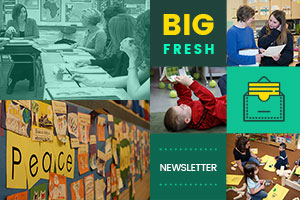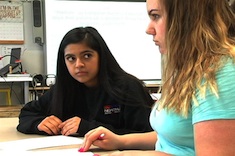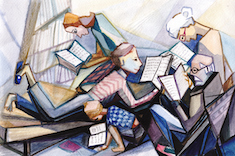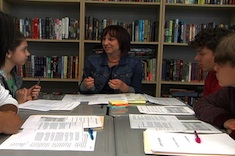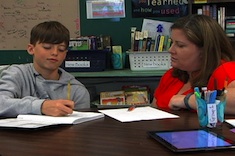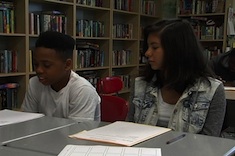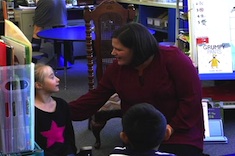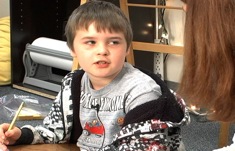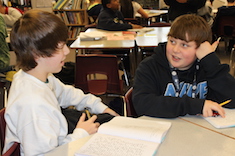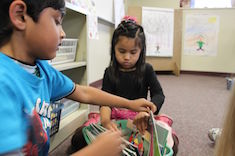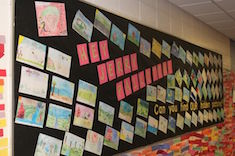Library
Choice Literacy Articles & Videos
The Choice Literacy library contains over 3,000 articles and 900 videos from 150+ contributors. Classic Classroom and Literacy Leadership subscribers have access to the entire library. Content is updated continuously, with five to six new features published each week.
Latest Content
The Big Fresh June 3, 2017 Bearing Walls
We conclude our series on creative takes on formative assessment in this week’s Big Fresh.
Consistent Feedback in Writing Workshop
Carly Ullmer assesses how she can give consistent and meaningful feedback to every one of her many middle school students at least once a week.
Tapping into What Students Know
Melanie Meehan shares the value of assessing what students know first, and then tapping into this knowledge in new units.
Assessing Learning: Quick Conferences
Leslie Lloyd completes quick assessment conferences with her third graders after a lesson on “literal” and “nonliteral” language, based on standards from the Common Core.
The Big Fresh May 27, 2017 Tyranny of the Score
We look at creative takes on formative assessment in this week’s Big Fresh.
Creating an On-Demand Writing Checklist
On-demand writing can be a stressful assessment task for students, but it does mimic the type of writing many adults face in their professional lives. Tara Barnett and Kate Mills work with students to create an on-demand writing checklist.
Assessing Instruction in the Midst
Melanie Meehan shares some ways teachers can press the pause button in the midst of teaching to assess whether they are teaching the right lesson at the right time.
Expert Students
Christy Rush-Levine uses a quick assessment during writing workshop conferences to connect expert students with peers who might need assistance. She includes a video example of the practice.
The Big Fresh May 20, 2017 Lollipop Moments
We conclude our series on home/school connections in this week’s Big Fresh.
Building Community and Family Connections
Tara Barnett and Kate Mills share suggestions for connecting with parents over the summer and early in the school year, including some fun uses of technology.
Literary Analysis: Tone and Scholarly Writing
Christy Rush-Levine shares how to help student writers understand and develop a scholarly tone. The feature includes a video example of small-group instruction.
Stretching Writing in First Grade
Katrina Edwards helps first grader Lila stretch her writing about going to a park on a rainy day.
Explaining a Workshop Model to Parents (Part 2)
ennifer Schwanke explains how jargon can trip up communication with parents, and lists which terms are worth defining. This is the final installment of her series on talking about literacy workshops with families.
The Big Fresh May 13, 2017 Illiterate?
We look at classroom talk in this week’s Big Fresh.
Monday Headlines
Tara Barnett and Kate Mills use Monday Headlines to energize students after the weekend, and get a peek into what’s going on at home.
Brainstorming Writing Topics with Drew
Katherine Sokolowski confers with Drew about writing at home, brainstorming possible topics. In the process she shows how much she knows about Drew's life outside of school.
Literary Analysis: Counterclaims
Christy Rush-Levine shares how to present counterclaims, as well as a video example of a small group exploring counterclaims.
Explaining a Workshop Model to Parents
Jennifer Schwanke explains why parent-teacher conferences can be bewildering for families, and offers advice for better ways to explain a literacy workshop model to them.
The Big Fresh May 6, 2017 Mentors Who Matter
We look at classroom talk in this week’s Big Fresh.
Mentor Texts and Important Reminders
Melanie Meehan shares four important tips for using mentor texts effectively with students of any age.
Using If I Stay to Model Literary Analysis
Christy Rush-Levine uses the mentor text If I Stay to model literary analysis, building on her middle school students’ interest in the recent movie.
First-Grade Minilesson: Reading Like Writers
Bitsy Parks teaches her first graders early in the year how to read like writers, highlighting examples from favorite mentor texts.
Building Relationships with Authors
Katie DiCesare is helping her students move from mentor texts to seeing authors as mentors through their websites and other digital resources.
The Big Fresh April 29, 2017 Teacher Voice
We look at classroom talk in this week’s Big Fresh.
Lunchtime Talk Practice
Katrina Edwards preps her students for lunchtime chats with classmates to foster more social and conversation skills.
Supporting Student Agency with Questioning Strategies
Katrina Simkins-Moore explains why becoming more intentional in questioning during reading conferences can help build student independence, as well as consistency among the teaching community.
Small Solutions for Big Problems with Classroom Discussions
Gretchen Schroeder shares some conversation fixes for when talk goes awry in her high school classroom.
The Big Fresh April 22, 2017 The Final Push
We look at literacy special events in this week’s Big Fresh.
Reading Ambassadors
Cathy Mere finds that a Reading Ambassadors program pays big dividends in building confident and conversant young readers.
Hosting Reading and Writing Events
Gigi McAllister explains why you have to be a bit choosy about reading and writing events since there are so many possibilities. Here are some she values in her fourth-grade classroom.
Browse Content By
Type
Category
- Assessment Tools
- Big Fresh Archives
- Booklists
- Choice Numeracy
- Classroom Design
- Common Core
- Community Building
- Conferring
- Content Literacy
- Digital Literacy
- English Language Learners
- Equity
- Family Relations
- Free Samples
- Guiding Groups
- Leadership
- Literacy Coaches
- Mentor Texts
- Minilessons
- New Teacher Mentors
- Podcasts
- Poetry
- Quote Collections
- Reading Strategies
- Self Care
- Struggling and Striving Learners
- Talking and Listening
- Teacher Study Groups
- Teaching Reading
- Teaching Writing
- Word Study and Vocabulary
Author
- Melissa Quimby
- Nawal Qarooni
- Gwen Blumberg
- Julie Cox
- The Lead Learners
- Hannah Tills
- Josie Stewart
- Ruth Metcalfe
- Mallory Messenger
- Becca Burk
- Jodie Bailey
- Vivian Chen
- Mary Brower
- Tiffany Abbott Fuller
- Stephanie Affinito
- Ruth Ayres
- Leigh Anne Eck
- Heather Fisher
- Shari Frost
- Julie Johnson
- Suzy Kaback
- Gigi McAllister
- Shirl McPhillips
- Melanie Meehan
- Cathy Mere
- Debbie Miller
- Tara Barnett and Kate Mills
- Tammy Mulligan
- Dana Murphy
- Bitsy Parks
- David Pittman
- Brenda Power
- Heather Rader
- Matt Renwick
- Mandy Robek
- Christy Rush-Levine
- Gretchen Schroeder
- Jen Schwanke
- Brian Sepe
- Katherine Sokolowski
- Stella Villalba
- Jennifer Vincent
Grade Level
Choice Literacy Membership
Articles
Get full access to all Choice Literacy article content
Videos
Get full access to all Choice Literacy video content
Courses
Access Choice Literacy course curriculum and training

